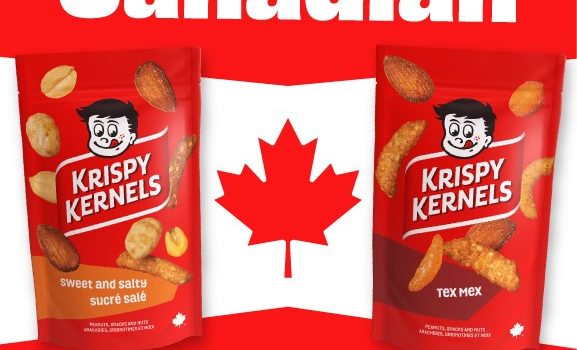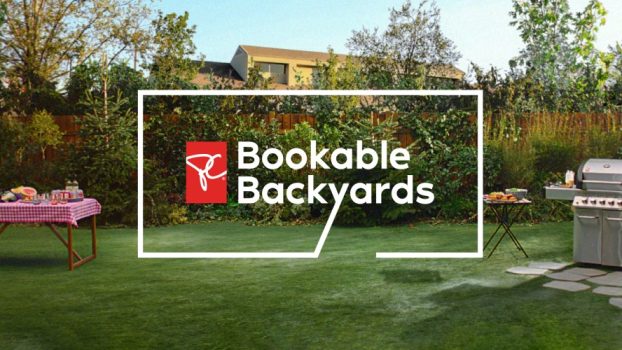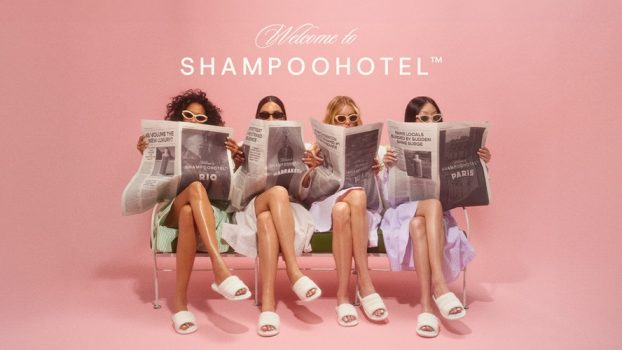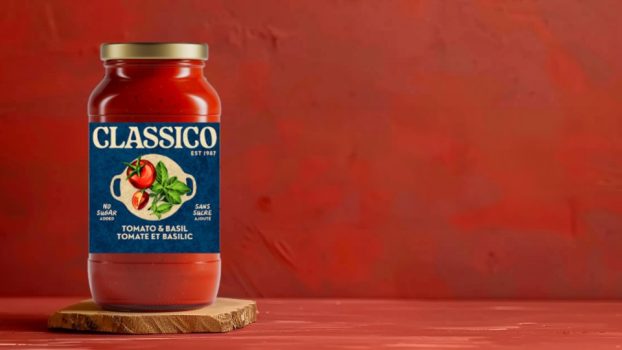In Quebec, he’s a popular guy. He’s number one actually. He’s got clean delivery with no aftertaste, yet has 5.5% alcohol. He’s high energy and has a bit of a ‘social charge’ about him. He’s priced averagely, yet too valuable to be discounted around beer guzzling weekends like May 24. Still, he’s as blue collar as you can get – a hometown boy with Quebec roots.
Now look at our guy in the rest of Canada – well, first you’ve got to find him, actually, because he’s far from popular here, regularly outshone by his more patriotic and sexually-charged brothers. He’s got that same clean aftertaste, but he’s a bit more upscale here. Or at least he was when we first met him back in the late ’80s. He was pushed as premium for his white collar friends, and priced higher to match. But he’s fallen from grace because these days, when you can find him, it might very well be in a discounted case to help celebrate Labour Day weekend.
So who is our guy? Molson Dry of course, who is a man of two brand faces – one for Quebec, and the other for the rest of Canada.
Montreal-based Molson Breweries is one of the few companies to actually admit it has two sets of brand properties to cater to different cultural tastes in the two regions. But many other companies still go to the trouble of hiring separate agencies to give their brand, if not a completely different set of attributes, then at least a very different embodiment in Quebec.
We do know that the Quebec population – with its distinct language, preferences and cultural differences – responds better to homegrown advertising than warmed over English creative. But when should a company develop two completely different brand characters for the two regions?
Well, you don’t, not if you can help it, says John Bailey, VP of marketing in Quebec for Molson. ‘My suggestion would be to go for common ground and only fall back onto different ones if you have to,’ he says. ‘That’s how I would normally approach it – nurture that common ground instead of thinking you have to be different and then stay different.’
But Molson Dry turned out to be a special case. After its 1989 launch, the initial push was to differentiate it by emphasizing that clean finish and higher alcohol percentage. But this common launch had very different results in the two regions: In English Canada, it got a bit lost among Molson’s other brands. In Quebec, Dry took off, enjoying an uphill climb to its present leadership position, which it reached in the mid-’90s.
Reacting to the marketplace, Molson focused its efforts on the brand in Quebec, where today it enjoys full marketing support, with Montreal’s Cossette Communication-Marketing continuing to produce ads emphasizing that ‘social charge.’
For instance, one recent 30-second spot, called ‘Cab,’ sees three men, arms full of work, one with a cellphone glued to his ear, trying to hail a cab. As the temperature rises, a cab finally pulls up and in the window’s reflection, a Molson Dry billboard is spotted. The three throw their work and cellphone into the cab and the car drives away. Our guys head down the street, noticeably relaxed now that they’re free to forget work and enjoy a Molson Dry.
For Molson, Dry is one of only two brands directed out of a Quebec-based agency office with a local director and VP of marketing (the other is Tornade).
Another Quebec-based company, Bell Canada, also took a completely different route in Quebec. A decade ago, it created a central character for its advertising, named Monsieur B., who uses humorous situations to illustrate the brand’s properties in the Quebec market. (One recent spot, ‘La Chorale,’ showcased a choir singing through the Internet, which was actually a layered Monsieur B. singing in different accents.)
While the base principles of the brand are the same across the country – namely service, reliability and strong product offering – the execution is so radically different, and has been for so long, that two different brand faces have emerged.
Like Molson, Bell didn’t necessarily set out to create two separate brands, but the brands evolved in different ways due to the differing cultures in the two regions. For example, Bell Canada tried introducing a similar approach to Monsieur B. in English Canada, by trying to create a familiar face for its brand with its ‘two guys’ ads (in which one would talk about Bell’s services, while the other remained silent), but the campaign was dropped in early 2000.
‘The English market isn’t as homogenous, and what is humorous to one isn’t humorous to another necessarily,’ says Ida Teoli, chief communications officer for Bell Canada. ‘We attempted a character who we thought would appeal to the younger audience and in doing so, we weren’t appealing to our more traditional base. So we decided to find a theme that was more universal, which is what ‘Go’ tries to do.’
‘Go,’ the English Canadian campaign, emphasizes choice and the things you can do with Bell’s services (such as calling a friend to look up what poison ivy looks like when think you’ve stepped in it, as shown in a recent spot).
Interestingly, both ‘Monsieur B.’ and ‘Go’ were created by the same agency – Cossette – although different regional offices were used, Montreal and Toronto respectively. But the two campaigns are handled by the same account director, and the two regional agency offices get briefed together as well.
‘In terms of money, it’s better to have one thing you execute differently,’ says Jacques Labelle, Cossette’s VP, creative director, who helped create Monsieur B. ‘But we have to ask ourselves: does this brand personality have pertinence in the market we want to advertise in?’
Like Bell, Pepsi also created a completely unique campaign for Quebec using a local character (this time the agency was BBDO Montreal). Unlike Bell and Molson, the Quebec brand is directed from out of province on the client side (from Mississauga, Ont.), but it’s got local support through a strong network of Quebec franchised bottlers. The combination of that and Pepsi’s home-grown advertising is the key to success in the province, says Richard Burjaw, director of marketing for carbonated soft drinks, Pepsi Cola Canada.
One thing successful brands in Quebec have in common is they do local work, says Burjaw. ‘Language is one of the reasons and our track record indicates another reason is that Quebecers appreciate – maybe more than the rest of Canada – local effort by a company.’
While again Pepsi prides itself on having the same basic brand platform everywhere – youthful spirit, fun, and a great-tasting product – in English Canada the company sometimes picks up U.S. creative (such as the recent Britney Spears ads), whereas in Quebec, they have used actor Claude Meunier for 18 years to advertise the brand. (Meunier is so involved that he helps write the ads and works with BBDO Montreal’s art director to bring truly unique Quebec perspectives to the advertising.)
So Quebecers are really exposed to the universal brand attributes with a French twist, thanks to Meunier. Local ads feature colourful local characters, and the common theme is ‘They love their Pepsi so much that they….’ (One of the latest such executions is built around Tony, a belligerent small grocery store owner who loves his Pepsi so much he won’t sell it to customers.)
Burger King takes the same strategy – it uses some pick-up creative in English Canada and new work is handled by Ammirati Puris in Toronto. But in Quebec, Montreal’s bleu blanc rouge creates local advertising for the local consumers. Home Depot, whose English Canadian advertising is handled out of the U.S. by Dallas-based The Richards Group, only has one agency in Canada – Cossette again – which handles Quebec creative only.
And how is this handled internally? Do multiple agencies mean multiple VPs of advertising? In general, no. Instead, one VP or director of advertising usually handles most markets, or there’s a structure in place where regional marketing directors report to one VP of marketing (as in Burger King’s case).
When it comes to the agencies, some companies, such as Pepsi and McDonald’s, use the local offices of national agencies such as BBDO or Cossette, and the two offices communicate and share information. In other cases, such as Burger King’s, the two regional agencies are unrelated. In these cases, they generally do share information, but don’t necessarily collaborate on creative.
Either way, it’s go big or go home. It’s this reality of the marketplace which, in the end, explains the tendency for different brand faces to emerge, despite the expense and tactical complications.
‘When you take a different position in a market, you have to go all the way with separate pricing, advertising, promotions, to totally support that positioning,’ Molson’s Bailey says. ‘But it’s an expensive route to take, especially these days when things are becoming more globalized.’
Which brand do you know?
While most brands have the same base attributes everywhere, some of the more sophisticated exhibit a different personality in Quebec compared to the rest of Canada. Below are some examples of how brands become manifest in different ways to appeal to the different outlooks and cultures of the two regions.
Pepsi
Base attributes: taste of the product; youthful spirit
Quebec incarnation: youthful spirit skew; actor Claude Meunier is the long-time star of the ads which depict scenarios unique to Quebec culture; ‘Aujourd’hui’ tagline
English Canada incarnation: U.S. spill featuring celebrities such as Britney Spears; Pepsi Taste Challenge; ‘Joy of Pepsi’ tagline; also use O-O-H ads to show how desirable Pepsi is (hands reaching out of a tray of ice cubes, straws worshipping a can of Pepsi)
Bell Canada
Base attributes: wide product offering; technology innovation
Quebec incarnation: long-running Monsieur B. spokesman uses humour, catches himself in odd situations, but still shows the attributes of Bell’s services
English Canada incarnation: ‘Go’ promotes the use of Bell’s technology, sometimes incorporating humour (tweens invade a household because it has Bell Sympatico high-speed access), sometimes merely depicting how the technology can bring people together (musicians around the world jamming on the Internet)
McDonald’s
Base attributes: community and emotion; taste of product; value for money
Quebec incarnation: long-running ‘J’aime’ tagline (which incorporates McDonald’s golden arches logo); promoting the community of McDonald’s; advertising that triggers emotions; executes more reputation-type advertising than in other regions
English Canada incarnation: also promotes McDonald’s community, but with different executions and a different tag: ‘There’s a little McDonald’s in everyone’
Danone yogurt
Base attributes: love of yogurt; good for you
Quebec incarnation: uses Quebec movie and television star Sophie Lorain in situations women can relate to (trying on a red dress while the sales associates suggests a more slimming black dress)
English Canada incarnation: supermodel Cindy Crawford talks about how she incorporates Danone into her day; also running the Sophie Lorain ads in English Canada, but with a lower recognition factor
Coca-Cola
Base attributes: taste of product; there for every special moment; social aspect, enjoying Coke with friends and family
Quebec incarnation: Olympic spot used Quebec speed skater Marc Gagnon, and showed Gagnon interacting with fans wishing him luck
English Canada incarnation: ‘He shoots, he scores’ Olympic spot featured various shots of people shooting on the net; had a strong nationalistic flavour























